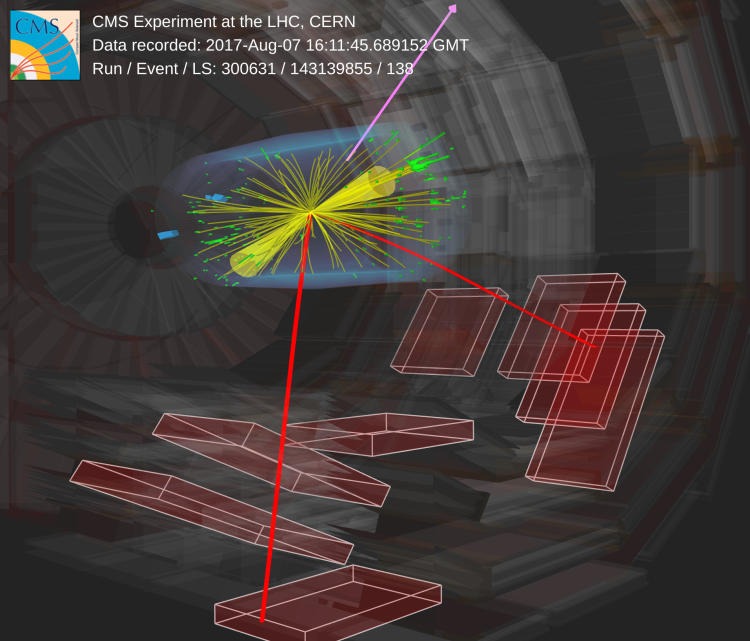
The term "Dark Matter" was coined in 1933 by Fritz Zwicky. While studying the Coma galaxy cluster, he observed that the galaxies were moving too fast to be bound by the visible mass alone. He concluded that something else, something invisible — Dark Matter — must be holding the cluster together. Since then, more and more evidence for DM has been accumulated. For example, by studying how clusters of galaxies bend the light that passes through them (an effect known as gravitational lensing), it is possible to deduce the total mass of the cluster. Observations of gravitational lensing indicate that there must be large amounts of invisible “dark” matter far beyond the visible mass of the cluster.
By measuring the distribution of temperature fluctuations in the Cosmic Microwave Background, scientists have determined that 85% of the matter in the universe is Dark Matter. However, 90 years after the term was first introduced, we still do not know the elementary nature of Dark Matter. We are certain that it is not one of the particles described by the Standard Model of Particle Physics (SM), prompting the consideration of new theories. One of the leading hypotheses is the existence of a new Weakly Interacting Massive Particle (WIMP). If WIMPs exist, they could annihilate into bottom quark-antiquark pairs, which subsequently decay and produce photons in a cascade. In fact, an additional source of gamma rays, known as the Galactic Center Excess (GCE), has been observed at the center of the Milky Way. This excess can be explained by the annihilation of dark matter particles with masses ranging from 10 GeV to 1 TeV, although one cannot separate it completely from astrophysical backgrounds.
Members of the CMS experiment from DESY and University of Hamburg in Germany and CBPF and UERJ in Brazil set out to test this hypothesis under laboratory conditions in the CMS detector. The collaboration arose from an exchange program.
Figure 1: Example Feynman diagram of the process: a bottom quark-antiquark pair is produced in association with a new heavy Higgs boson (“H”) that decays into a Z boson and a mediator particle “a”. In the final state, there are a muon-antimuon (or electron-antielectron) pair, a bottom quark-antiquark pair, and Dark Matter candidates “χ”.
Considering that WIMPs would annihilate into bottom quark-antiquark pairs, they could also be observed in proton-proton collisions at the LHC. This requires including new particles that could create this annihilation process. As an example, the GCE could be caused by a new light boson "a" that acts as a mediator between the Dark Matter candidate and the SM particles. “It is remarkable how data from the LHC can be used to probe the production of Dark Matter and how this can be related to astrophysical phenomena”, said Gilson Correia Silva, a postdoctoral researcher at DESY.
In this search, we look for a final state with a bottom-antibottom quark pair (that is produced with a new heavy Higgs boson “H”), a pair of muons or electrons (as a decay product of the Z boson), and the presence of the Dark Matter candidate χ appearing as a large momentum imbalance in the CMS detector, as schematically presented in Fig. 1. In order to enhance our chances of unveiling such a rare process, we make use of sophisticated machine learning techniques and look for specific patterns of the signal process that help distinguish it from all the other processes with similar final state signatures. A candidate event from the analyzed data sample is shown in Fig. 2.
Figure 2: A Dark Matter candidate event in proton-proton collisions at a center of mass energy of 13 TeV. In this candidate event, the Z boson decays into a pair of muons (red lines), bottom quark-antiquark jets (yellow cones), as well as an energy imbalance in the transverse plane (purple arrow). You can zoom and rotate also in this separate page.
With the sample of selected candidates in hand and an estimate of the background processes, we can compute the probability of having observed Dark Matter candidates at the CMS detector. The results are expressed in terms of the parameters of the model that predicts such a process. One of the parameters is the mass of mediator particle "a", which is considered the portal to the Dark Sector. We can probe how sensitive this search is and narrow down the allowed model parameter region for Dark Matter production. An example is shown in Fig 3.
Figure 3: Highest allowed Dark Matter production probabilities for a few mass hypotheses (mH) of a new heavy Higgs (“H”) as a function of the mass of the mediator particle “a” (ma).
This is the first Dark Matter search performed for this channel at the LHC. It is an impressive proof of the LHC's power to bridge the gap between particle physics and cosmology. “It is exciting to perform this search at the LHC for the first time and to explore new ways to search for Dark Matter even though it has been almost a hundred years since the idea arose”, said Raphael Gomes de Souza, PhD student from UERJ-Brazil.
Edited by: Muhammad Ansar Iqbal and Abideh Jafari
Read more about these results:
-
CMS Physics Analysis Summary (SUS-23-018) "Search for dark matter produced in association with two b quarks and two leptons at 13 TeV "
-
Display of collision events: CERN CDS
-
@CMSExperiment on social media: Bluesky - Facebook - Instagram - LinkedIn - TikTok - Twitter/X - YouTube

